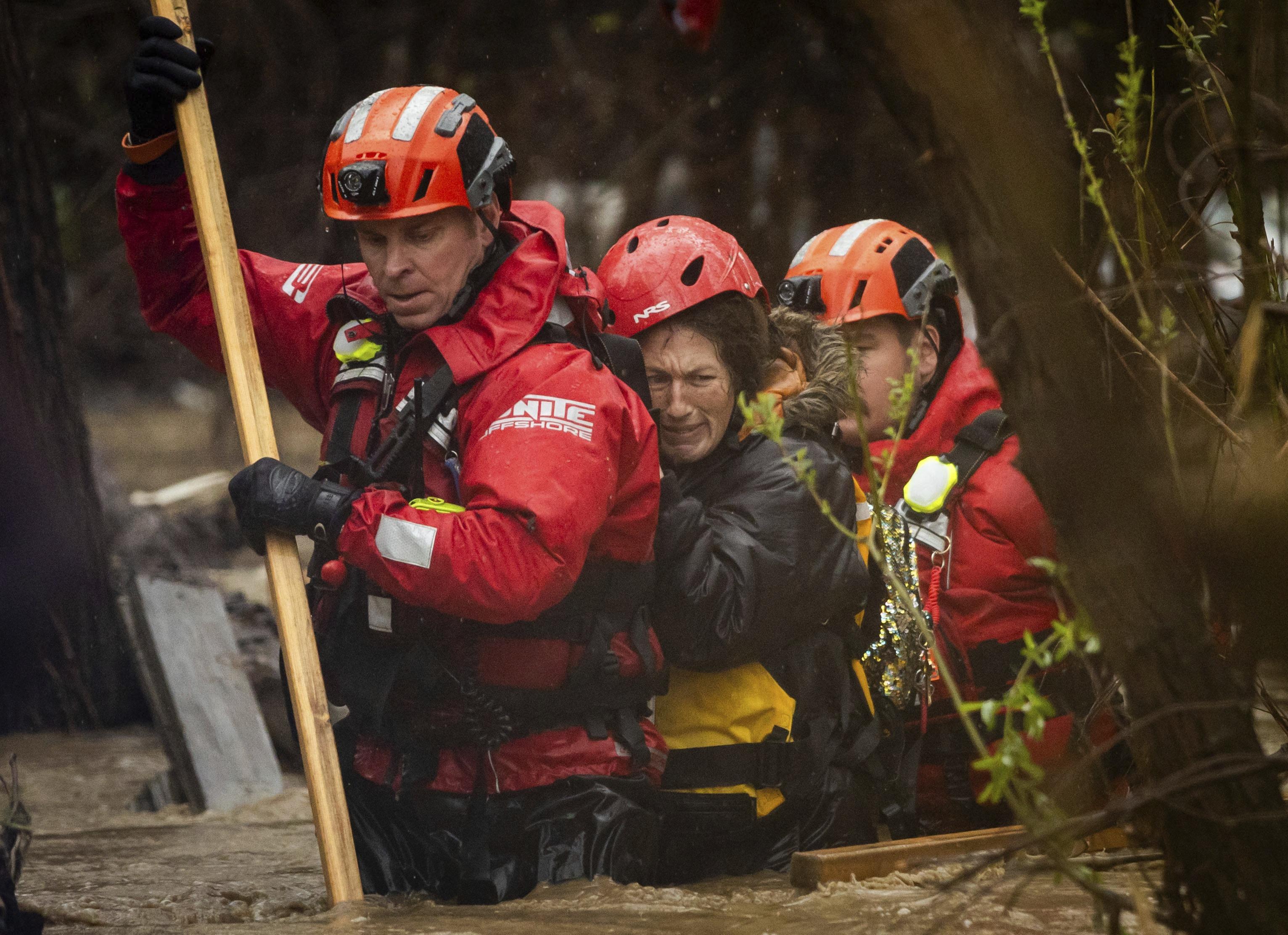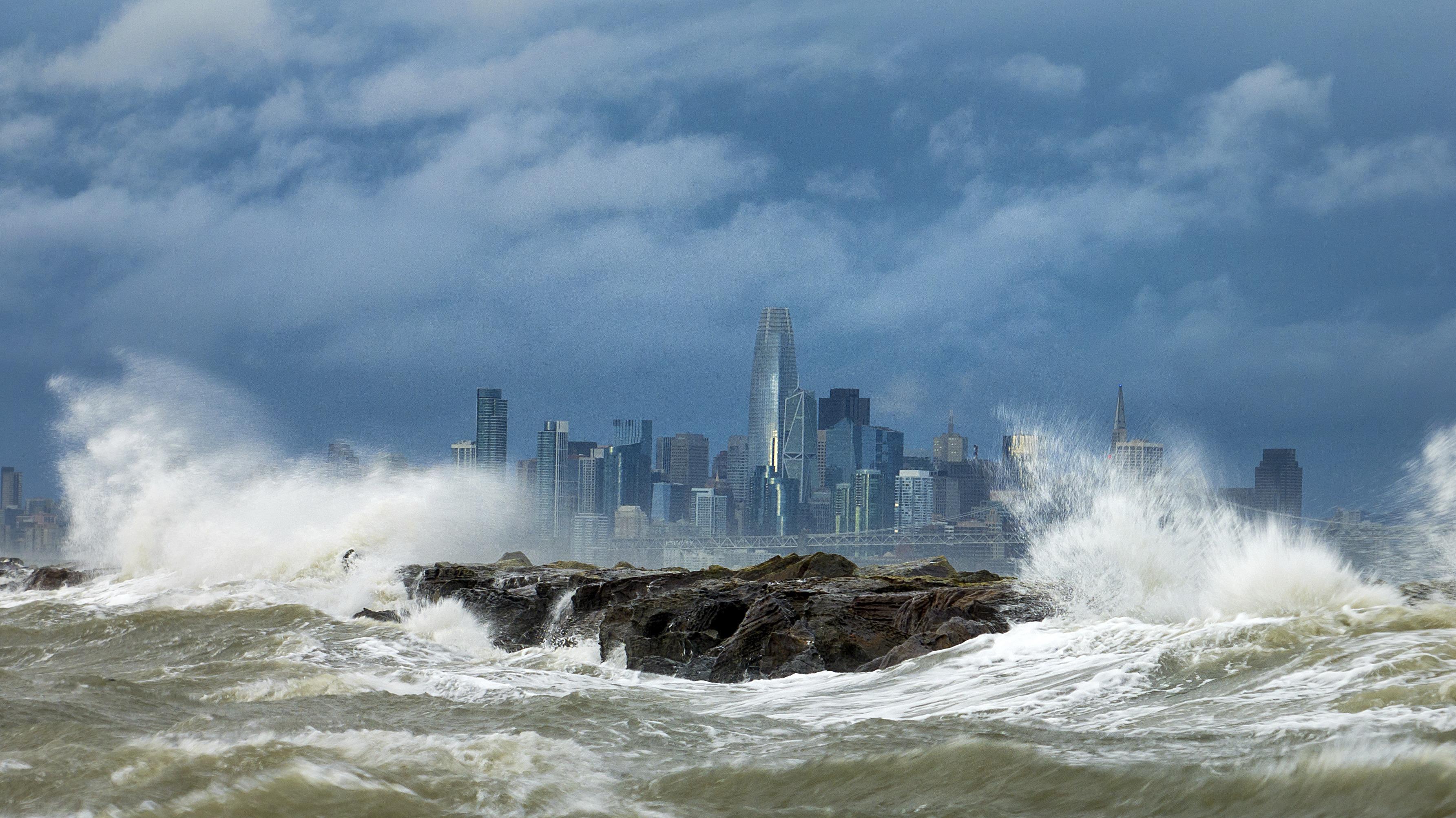 Firefighters rescue a woman from a homeless encampment that became surrounded by floodwater in the Santa Ana River during a rainstorm, Monday, Feb. 5, 2024, in San Bernardino, California. (PHOTO / AP)
Firefighters rescue a woman from a homeless encampment that became surrounded by floodwater in the Santa Ana River during a rainstorm, Monday, Feb. 5, 2024, in San Bernardino, California. (PHOTO / AP)
LOS ANGELES - A deadly Pacific storm, the second "Pineapple Express" weather system to sweep the West Coast in less than a week, dumped torrential rain over Southern California on Monday, triggering street flooding and mudslides throughout the region.
Extreme-weather advisories for floods, high wind and winter storm conditions were posted on Monday across parts of California and southwestern Arizona where some 35 million people live, and authorities urged residents to limit their driving.
ALSO READ: Heavy rains, wind pound California, seen as only the beginning
The National Weather Service documented staggering rainfall amounts from the storm, which lashed Northern California on Sunday with hurricane-force gusts of wind, along with heavy precipitation that intensified as the system moved south on Sunday night and Monday.
 Waves crash over a breakwater in Alameda, California, with the San Francisco skyline in the background on Feb 4, 2024. (PHOTO / AP)
Waves crash over a breakwater in Alameda, California, with the San Francisco skyline in the background on Feb 4, 2024. (PHOTO / AP)
The National Weather Service (NWS) said more than 25cm of rain had fallen since Sunday across the Los Angeles area, the nation's second-largest city, with much more expected before the downpour was due to taper off later in the week.
Nearly a foot of rain was measured over a 24-hour period on the campus of the University of California at Los Angeles (UCLA).
"We're talking about one of the wettest storm systems to impact the greater Los Angeles area" since records began, Ariel Cohen, chief NWS meteorologist in LA, told an evening news conference. "Going back to the 1870s, this is one of the top three."
I was driving up here last night, right after the Grammys, and coincidentally, my neighbor, who was in this SUV behind us, was being dropped off at his house, and the driver's coming down the hill, and the mud is chasing the drive...
Jeb Johenning, Beverly Hills resident
US President Joe Biden spoke to California Governor Gavin Newsom and Los Angeles Mayor Karen Bass and pledged to provide federal aid to areas hard hit by a Pacific storm pummeling the state, the White House said.
The Los Angeles Police Department reported scores of traffic collisions with injuries since the storm began, many more than usual, while city Fire Chief Kristin Crowley said her crews had responded to at least 130 flooding incidents by Monday morning.
READ MORE: Chile firefighters pull bodies from rubble, death toll hits 122
In one such incident, a fire department helicopter team rescued a man who had jumped into the churning waters of the Pacoima Wash, a concrete flood channel, in a desperate attempt to save his dog, department officials said.
The man was ultimately hoisted to safety, as seen in video footage shot by a firefighter and posted to social medial, while his pet managed to dog-paddle to the edge and also survived.
Second atmospheric river in days
The intense rainfall, with heavy snow in high-elevation mountain areas, was carried to California by a storm system meteorologists call an atmospheric river, a vast airborne current of dense moisture funneled inland from the Pacific.
The latest tempest, and a less powerful storm that hit California on Wednesday and Thursday, also qualified as a "Pineapple Express", a type of atmospheric river originating from the subtropical waters around Hawaii.
Winds gusting to 75 miles per hour (121 kph) on Sunday downed trees and utility lines across the San Francisco Bay Area and California's Central Coast, knocking out power to roughly 875,000 homes at the storm's peak in that region.
At least two people were killed by wind-toppled trees on Sunday - an 82-year-old man in the former gold rush town of Yuba City and a 45-year-old man at Boulder Creek in the coastal Santa Cruz Mountains.
 A large mudslide that occurred at the intersection of Beverly Drive and Beverly Place in the Beverly Crest area of Los Angeles damaged homes and cars, Feb 5, 2024. (PHOTO / AP)
A large mudslide that occurred at the intersection of Beverly Drive and Beverly Place in the Beverly Crest area of Los Angeles damaged homes and cars, Feb 5, 2024. (PHOTO / AP)
The greatest flash-flooding threat on Monday centered on Southern California, the NWS said, as the system slowly pivoted and pushed farther into the interior of California, but forecasters said "catastrophic" impacts were unlikely.
"There's widespread, significant flooding, and locally serious and severe flooding, but nothing that is completely off-the-walls insane," UCLA meteorologist and climate scientist Daniel Swain said during a YouTube briefing on Monday.
Hillside communities hardest hit
A number of upscale communities built on the slopes of the Hollywood Hills, Beverly Hills and Topanga Canyon were among the hardest hit by from landslides.
Los Angeles officials reported 120 mudslides and debris flows throughout the city on Monday, and at least 25 structures damaged by heavy rainfall or mudslides as of Monday evening, Crowley said.
Beverly Hills resident Jeb Johenning, standing in a neighborhood where cars stood half buried in muck and debris, said he noticed three fissures had opened on a hillside near his home, releasing "an avalanche of mud" down the slope.
READ MORE: Plane crashes into Florida mobile home, killing pilot, two others
"I was driving up here last night, right after the Grammys, and coincidentally, my neighbor, who was in this SUV behind us, was being dropped off at his house, and the driver's coming down the hill, and the mud is chasing the driver," Johenning recalled.
Still, the overall extent of property damage in the region appeared less severe than might have been expected given record amounts of precipitation, Swain said, citing two possible reasons.
Rainfall rates were diminishing as the storm wore on, and last summer's Southern California wildfire season was mild compared with some previous years, leaving more hillsides and canyon walls able to withstand a heavy soaking without collapse.


